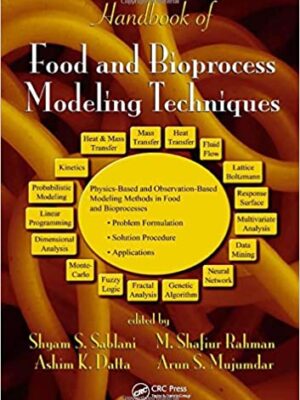Mathematics for Physical Chemistry
Original price was: ₹4,628.14.₹3,702.51Current price is: ₹3,702.51.
ISBN: 9780124158092
Author/Editor: Robert G. Mortimer
Publisher: Elsevier
Year: 2013
1 in stock (can be backordered)
Description
Mathematics for Physical Chemistry is the ideal supplementary text for practicing chemists and students who want to sharpen their mathematics skills while enrolled in general through physical chemistry courses. This book specifically emphasizes the use of mathematics in the context of physical chemistry, as opposed to being simply a mathematics text.
This 4e includes new exercises in each chapter that provide practice in a technique immediately after discussion or example and encourage self-study. The early chapters are constructed around a sequence of mathematical topics, with a gradual progression into more advanced material. A final chapter discusses mathematical topics needed in the analysis of experimental data.
Numerous examples and problems interspersed throughout the presentations
Each extensive chapter contains a preview and objectives
Includes topics not found in similar books, such as a review of general algebra and an introduction to group theory
Provides chemistry-specific instruction without the distraction of abstract concepts or theoretical issues in pure mathematics
Additional information
| Weight | 0.88 kg |
|---|
Product Properties
| Year of Publication | 2013 |
|---|---|
| Table of Contents | Dedication Preface Chapter 1. Problem Solving and Numerical Mathematics 1.1 Problem Solving 1.2 Numbers and Measurements 1.3 Numerical Mathematical Operations 1.4 Units of Measurement 1.5 The Factor-Label Method 1.6 Measurements, Accuracy, and Significant Digits Problems Chapter 2. Mathematical Functions 2.1 Mathematical Functions in Physical Chemistry 2.2 Important Families of Functions 2.3 Generating Approximate Graphs Problems Chapter 3. Problem Solving and Symbolic Mathematics: Algebra 3.1 The Algebra of Real Scalar Variables 3.2 Coordinate Systems In Two Dimensions 3.3 Coordinate Systems in Three Dimensions 3.4 Imaginary and Complex Numbers 3.5 Problem Solving and Symbolic Mathematics Problems Chapter 4. Vectors and Vector Algebra 4.1 Vectors in Two Dimensions 4.2 Vectors in Three Dimensions 4.3 Physical Examples of Vector Products Problems Chapter 5. Problem Solving and the Solution of Algebraic Equations 5.1 Algebraic Methods for Solving One Equation with One Unknown 5.2 Numerical Solution of Algebraic Equations 5.3 A Brief Introduction to Mathematica 5.4 Simultaneous Equations: Two Equations with Two Unknowns Problems Chapter 6. Differential Calculus 6.1 The Tangent Line and the Derivative of a Function 6.2 Differentials 6.3 Some Useful Derivative Identities 6.4 Newton? Method 6.5 Higher-Order Derivatives 6.6 Maximum?inimum Problems 6.7 Limiting Values of Functions 6.8 l??ital? Rule Chapter 7. Integral Calculus 7.1 The Antiderivative of a Function 7.1.1 Position, Velocity, and Acceleration 7.2 The Process of Integration 7.2.1 The Definite Integral as an Area 7.2.2 Facts about Integrals 7.2.3 Derivatives of Definite Integrals 7.3 Tables of Indefinite Integrals 7.4 Improper Integrals 7.5 Techniques of Integration 7.6 Numerical Integration Problems Chapter 8. Differential Calculus with Several Independent Variables 8.1 Functions of Several Independent Variables 8.2 Changes in a Function of Several Variables, Partial Derivatives 8.3 Change of Variables 8.4 Useful Partial Derivative Identities 8.5 Thermodynamic Variables Related to Partial Derivatives 8.6 Exact and Inexact Differentials 8.7 Maximum and Minimum Values of Functions of Several Variables 8.8 Vector Derivative Operators Problems Chapter 9. Integral Calculus with Several Independent Variables 9.1 Line Integrals 9.2 Multiple Integrals Problems Chapter 10. Mathematical Series 10.1 Constant Series 10.2 Power Series 10.3 Mathematical Operations on Series 10.4 Power Series with More than One Independent Variable Chapter 11. Functional Series and Integral Transforms 11.1 Fourier Series 11.2 Other Functional Series with Orthogonal Basis Sets 11.3 Integral Transforms Problems Chapter 12. Differential Equations 12.1 Differential Equations and Newton? Laws of Motion 12.2 Homogeneous Linear Differential Equations with Constant Coefficients 12.3 Inhomogeneous Linear Differential Equations: The Forced Harmonic Oscillator 12.4 Differential Equations with Separable Variables 12.5 Exact Differential Equations 12.6 Solution of Inexact Differential Equations Using Integrating Factors 12.7 Partial Differential Equations 12.8 Solution of Differential Equations using Laplace Transforms 12.9 Numerical Solution of Differential Equations Problems Chapter 13. Operators, Matrices, and Group Theory 13.1 Mathematical Operators 13.2 Symmetry Operators 13.3 The Operation of Symmetry Operators on Functions 13.4 Matrix Algebra 13.5 Determinants 13.6 Matrix Algebra with Mathematica 13.7 An Elementary Introduction to Group Theory 13.8 Symmetry Operators and Matrix Representations Chapter 14. The Solution of Simultaneous Algebraic Equations with More than Two Unknowns 14.1 Cramer? Rule 14.2 Linear Dependence and Inconsistency 14.3 Solution by Matrix Inversion 14.4 Gauss?ordan Elimination 14.5 Linear Homogeneous Equations 14.6 Matrix Eigenvalues and Eigenvectors 14.7 The Use of Mathematica to Solve Simultaneous Equations 14.8 The Use of Mathematica to Find Matrix Eigenvalues and Eigenvectors Problems Chapter 15. Probability, Statistics, and Experimental Errors 15.1 Experimental Errors in Measured Quantities 15.2 Probability Theory 15.3 Statistics and the Properties of a Sample 15.4 Numerical Estimation of Random Errors Problems Chapter 16. Data Reduction and the Propagation of Errors 16.1 The Combination of Errors 16.2 Curve Fitting 16.3 Data Reduction With A Derivative Problems Appendices Appendix A Values of Physical Constants Appendix B Some Mathematical Formulas and Identities Appendix C Infinite Series Appendix D A Short Table of Derivatives Appendix E A Short Table of Indefinite Integrals Appendix F A Short Table of Definite Integrals Appendix G Some Integrals with Exponentials in the Integrands: The Error Function Appendix H Answers to Selected Numerical Exercises and Problems Chapter 16 Additional Reading Books on Mathematics for Science Calculus Textbooks Books on Numerical Analysis Advanced Mathematics Books Books on Group Theory Books on Experimental Data Analysis Computer Books Problem-Solving and Problem Books Mathematical Tables Websites |
| Author | Robert G. Mortimer |
| ISBN/ISSN | 9780124158092 |
| Binding | Paperback |
| Edition | 4 |
| Publisher | Elsevier |
You must be logged in to post a review.






Reviews
There are no reviews yet.